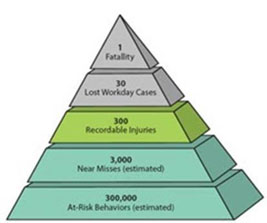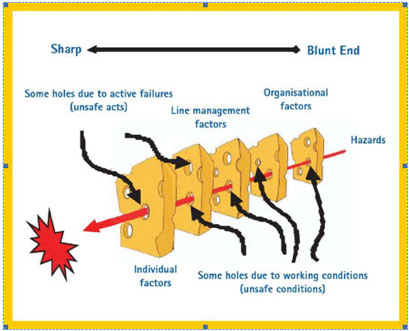Most people understand reporting events, hazards and near misses are extremely important but most of us don’t want to for a variety of reasons. A few of these reasons may include:
- You don’t really believe the event or hazard you saw is really that significant and is not worth the time and effort to report
- You don’t see the hazard or near miss escalating to the point someone will actually be injured
- You see a co-worker doing something in an unsafe way but, you inherently don’t like conflict and would feel uneasy speaking up
- You are busy and really don’t have time to stop and report things right now
- You believe that if you do report something, you are going to be tied up with the report and will be under more pressure once done to catch up on the work you should have been doing
And there are many, many more reasons.
At-Risk-Behaviour

Figure 1 – Frank Bird Triangle
Frank Bird’s Tringle, was developed in the 1960’s. His conclusion was one thing led to another and ultimately resulted in something catastrophic eventually. His estimates of underlying at risk behaviours led to near misses and eventually events causing injury or harm to workers. Other researches explain a domino effect or the lining up of factors leading to an event.
Many have disputed this research and similar work by others but most people will agree the majority of workplace incident occurred because someone made a choice and that choice put them in danger. The choices we make are usually based on our interpretation of risk vs reward. We constantly make this decision in our work and personal lives. Its human nature.
Most statistics back up the triangle but can only be properly seen if the workplace has a strong reporting culture.
A lot of hazards and near misses are never reported so the actual near misses and at risk behaviours may be a lot higher in frequency than the above triangle.
We can’t accept at risk behaviours as once a precedent is set, others will follow the lead especially if those who cut corners receive positive feedback based on output or production improvements.
Safety in design of plant equipment

Figure 2 – James Reason’s Swiss Cheese Model of Accident Causation
The remaining causes of significant events stems from the mechanical, engineering safety in design of plant or equipment. Often we are unaware there is a potential flaw in the design, process or engineering which leads to catastrophic events that make the news.
What we can do is not accept flaws in the function or structure of the tools, equipment, or plant by checking them rigorously before and during use.
Unsafe processes or procedures
Finally, the last cause of events stems from unsafe processes or procedures of completing a task. Most procedures in our workplaces have been developed over the years, often borrowed from other organisations and altered to fit the working environment, but almost all have been developed due to the result of a workplace incident. Learning by our mistakes.
Procedures are developed with the intention to educate those doing the actual job and allow reference in case people are unsure. Procedures also set the consistent standard, demanded by the employer that the workers are required to abide by as per workplace safety legislation.
Keeping documents current and understandable
What you can do is; take time to understand the company documents. Base your tasks according to the documented processes and make sure you are utilising the latest version of the document. Question the document by speaking to your supervisor, if there is an error or you don’t agree with it, speak up. You may be saving you and your workmates grief in the future.
Think about how you would educate your kids, younger sibling, or mate who has just started on the job.
You are not going to teach them or demonstrate unsafe behaviours because you know that will put them at risk.
We require you to go one step further and make an effort to look critically at the workplace, do you pre starts, participate in the safety observation program and complete the required supervisor inspections.
REPORT WHAT YOU SEE!
It does take time, but it takes more time to fix or investigate something if it’s actually gone wrong. Supervisors must remain vigilant to educate the workforce and promote best practice at all times; this is the core function of the position.
If behaviours, hazards and events are reported correctly, we can develop strategies to ensure they don’t escalate or repeat. That’s how we improve workplace safety. Looking out for yourself and your workmates and working as a team to demonstrate effective and safe work practices.
Should you require assistance in culture change related to incident reporting contact us:
Tell: 08 6311 7043
Email: cservice@ussaglobal.com
